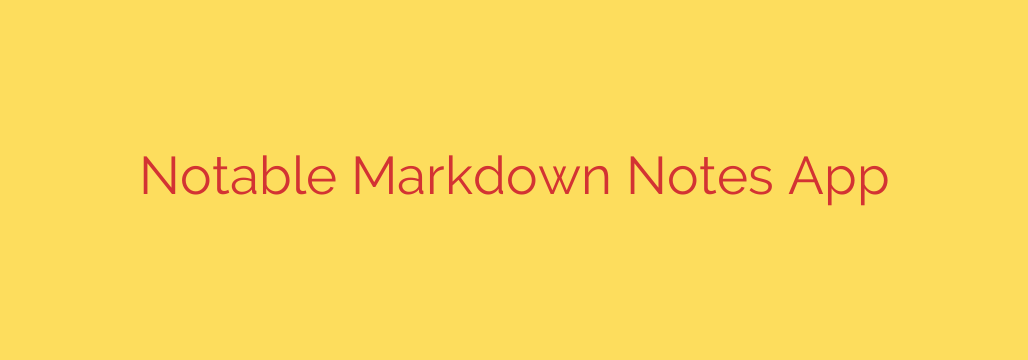
Streamline Your Workflow: Discover the Power of a Markdown Notes App
In a world of cluttered desktops and proprietary software, the quest for the perfect note-taking system can feel endless. We juggle apps that lock our data into specific formats, making it difficult to switch or access notes in the future. But what if the solution was simpler? What if your notes could be as portable, readable, and future-proof as a plain text file?
This is the promise of Markdown-based note-taking. By combining the simplicity of plain text with powerful, intuitive formatting, a dedicated Markdown notes app can revolutionize how you capture, organize, and connect your ideas.
What Exactly is Markdown?
At its core, Markdown is a lightweight markup language created to make formatting text easy and readable. Instead of complex menus and buttons, you use simple characters to style your text. For example:
# Heading 1becomes a main heading.## Heading 2becomes a subheading.*italic text*or_italic text_becomes italic text.**bold text**or__bold text__becomes bold text.
The beauty of this system is its universality. A Markdown file (.md) is just a text file that can be opened by virtually any editor on any device, now and in the future. You are never locked into a single app or ecosystem.
Key Features of a Superior Markdown Notes App
While you can write Markdown in any text editor, a specialized application supercharges the experience. Here’s what sets a great Markdown notes app apart.
A Clean, Distraction-Free Interface: The primary goal is to help you focus on your thoughts. A top-tier app provides a clean writing canvas, often with a split-screen view that shows your raw Markdown on one side and the beautifully rendered preview on the other. This lets you write without interruption while seeing the final output in real-time.
Powerful Organization with Tags and Notebooks: Chaos is the enemy of productivity. The ability to organize notes within nested notebooks acts as a digital filing cabinet. Furthermore, a flexible tagging system allows for cross-category organization. You can add multiple tags (e.g.,
#project-alpha,#meeting,#ideas) to a single note, making it instantly discoverable through search, no matter where it’s filed.Seamless Inter-Note Linking: This is where a simple note-taking app transforms into a personal knowledge base. By allowing you to easily create links between related notes, you can build a web of interconnected ideas. This “Zettelkasten” or “personal wiki” approach is incredibly powerful for research, brainstorming, and connecting disparate thoughts into a cohesive whole.
Robust Attachment and Media Support: Your notes aren’t just text. A great app allows you to drag and drop images, PDFs, and other files directly into your notes. These attachments are stored alongside your text files, keeping all relevant information for a project in one secure place.
Emphasis on Privacy and Data Control: Your notes are your data. The best applications are built with a local-first philosophy, meaning all your notes and attachments are stored directly on your device, not on a company’s cloud server. This gives you complete ownership and control over your information. You decide where to store it, how to back it up, and who gets to see it.
Actionable Security and Productivity Tips
To get the most out of your Markdown note-taking system, follow these best practices:
Choose Your Storage Location Wisely: Since your notes are stored as local files, you can place them in a folder synced with a trusted cloud service like Dropbox, Google Drive, or a private solution like Nextcloud. This gives you both local control and the convenience of cloud backup and synchronization across devices.
Establish a Consistent Tagging System: From the beginning, decide on a clear and simple structure for your tags. For example, use prefixes like
p-for projects (p-website-redesign),s-for status (s-inprogress), andt-for topics (t-marketing). This discipline makes searching for notes dramatically more efficient as your collection grows.Backup Your Notes Folder Regularly: Even if you use a cloud sync service, it’s a good security practice to create periodic local backups of your entire notes folder. Simply zip the folder and store it on an external drive. Since it’s all plain text, the file size will be minimal, and you’ll have a permanent, offline archive of your knowledge.
By embracing a Markdown-based workflow, you’re not just choosing a new app—you’re adopting a philosophy of data ownership, flexibility, and long-term productivity. It’s a powerful way to clear the clutter and build a knowledge base that will serve you for years to come.
Source: https://www.linuxlinks.com/noteworthy-markdown-notes-app/








